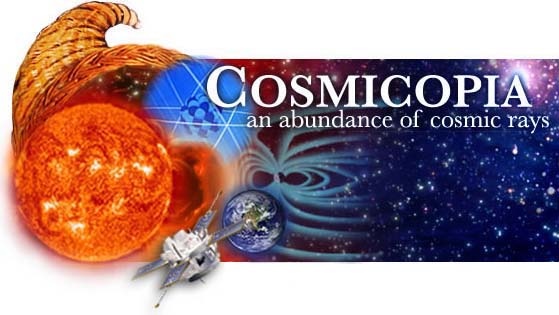
Ask Us
General Physics:
Waves - Light and Sound
Light Affected by Gravity?
Is light affected by gravity? If so, how can the speed of light be constant? Wouldn't the light coming off of the Sun be slower than the light we make here? If not, why doesn't light escape a black hole?Yes, light is affected by gravity. Gravity can change the direction of travel of light, and can also change its energy. But the change in energy comes about by changing the wavelength of light, not it's speed. So the light coming off the Sun is slightly longer in wavelength than the same original wavelength generated on Earth, but is still moving at the same speed. This is called gravitational redshift. The gravitational redshift of a black hole is enough that all light is reduced to infinite wavelength, and so no energy escapes.
Dr. Eric Christian
Speed of Light vs Speed of Sound
How do sound and light arrive at the same time when light travels faster than sound?This is a good and interesting question that is rooted in everyday experience. Indeed, it appears that sound and light arrive simultaneously when we attend a play in a theater or watch a movie. The reason is that we are very close to the stage or screen and loudspeaker. This may already be different during a concert in a stadium: For somebody in the distant rows the sound of the band and its movement is out of synch. The speed of sounds is approx. 300 m/s (1000 ft/s), while the speed of light is 300,000 km/s (approx.190,000 miles/s). Therefore, the sound arrives about 1/3 of a second after the corresponding movement, i.e. starts to be recognizable. In a theater the time difference is too short to be recognized.
The most striking experience of the different speed of light and sound is during a thunderstorm. Unless the thunderstorm is exactly upon us, a silent lightning is followed by a substantially delayed thunder. Yet both originate the same place and time. In fact, one can estimate the distance of the thunderstorm from the difference by counting .twenty-one, twenty-two, etc.. starting with the lightning. Saying each number takes about one second. The distance of the thunderstorm in miles is the number of seconds counted dived by five. Thus a thunderstorm is a great time to find out without instrumentation that sound is indeed much slower than light.
Dr. Eberhard Moebius
(November 2003)Speed of Sound - Underwater
Why does sound travel four times faster through water than it does through air?Sound waves are a result of the compressive disturbance of a continuous medium (air, liquid, solid). The material tries to restore the original state, and the disturbance propagates as a sound wave. The speed of the wave depends on the properties of the medium ("springiness" or elasticity, which tries to restore the original state, and the inertia or mass, which works to continue any motion).
In a gas, the sound speed depends on the ratio of pressure (springiness) to the mass density of the gas.
In a solid or liquid, the elasticity is described by the "bulk modulus" which is tabulated in a number of places.
Using a standard formula and the tabulated values, one gets about 1480 meters/sec for sound in water, and for air at 20 degrees C, about 340 meters/sec. This gives your factor of 4. There is no fundamental reason for the factor of 4, it just depends on the properties of the materials. Sound in steel propagates much more rapidly than in water.
The HyperPhysics web site at Georgia State University gives a useful discussion of the various points.
Dr. Randy Jokipii
(April 2004)Motion of Light
I've often wondered about the wave component of light. Models show the distance traveled by light as a straight line but disregard the distance of the curve (sine wave). If you look at the shoreline, you can see that water actually moves as a medium for the energy of a wave. This up-down movement of the water can actually hit speeds faster than the leading edge of the wave itself. It's only natural to assume there is a medium for light and this medium must also move, accelerating and decelerating as it maps the wave, the higher the amplitude and frequency, the faster the speed at the zero mark. In other words, some component of light must move faster than the leading edge. Even if you believe light needs no medium, the energy still maps a sine wave. How can you reconcile this?The question on the speed of light, or more generally for the speed of a wave, is a very intriguing one. It may indeed seem puzzling to you that the speed of a wave is solely evaluated as the speed along the straight line of its propagation, while the wave appears to follow a wavy motion. When trying to understand this, one has to recognize what is propagating and what is not propagating.
You can try this with a simple experiment: Take a cloth line, tie one end to a door knob (or similar), then keep the other end in your hand, and walk as far as to straighten and tighten the cloth line. Now pull on the line with your other hand to produce a kink and let go of it. You will see that this disturbance of your otherwise straight line will now travel to the other end. If the line is tight enough, the disturbance will be reflected at the doorknob and travel back to you. You have created a wave (or more accurately a transverse wave -- the disturbance swings at a right angle to the direction of its propagation).
Are the fibers of the cloth line rushing from one end to the other? Probably not! It is only the disturbance that travels. Of course, the fibers swing back and forth from side to side, but on average they stay put.
The cloth line is a nice analogy for light, in the sense that light is also a transverse wave. However, light doesn't need a medium that it has to agitate. Light is electric and magnetic fields. When you turn on an electromagnet near a piece of iron, nothing is moving toward that piece of iron to attract it. Just the magnetic field itself does the trick.
Here is another example that you can watch yourself: If you observe a water wave carefully, you will see similar behavior to the cloth line. Throw a piece of wood on the water and let it float there. When a wave comes by (from a passing boat or such), the piece of wood will dance up and down. In addition, it will move slightly back and forth, as the water surface elements move in small circles in a water wave. However, the wood will not move forward, unless the wave crests start to overturn and trap the wood. This peculiar behavior of water waves only occurs on the slope of a beach, where the water gets shallower.
Dr. Eberhard Moebius
(October 2003)Doppler Shift of Light
The theory of the expanding universe depends on the redshift, a consequence of the Doppler effect applied to light. But it doesn't seem like the Doppler effect should be applicable to light. The equation "frequency * wavelength = velocity" gives the relative speed of the observer with respect to the wave source from the perceived frequency at constant wave length, as is the case with the Doppler effect observed for sound. But when applied to light, the right hand side of the equation becomes the constant c and there is no longer a correlation between a perceived frequency (or wavelength) and relative speed. So how can the redshift be used to measure therate at which stars are receding from us?You have a few things confused here which I can try to clear up.
The Doppler effect does not mean that the speed of the wave - be it sound or light - changes with respect to the observer. If the source and observer are moving relative to each other, the Doppler effect says that the frequency that is observed will be shifted (up or down) depending on the direction of relative motion (toward or away). The speed always stays fixed. So in the equation: frequency * wavelength = velocity, as the frequency goes down, the wavelength must go up, such that the velocity is constant. Here are a couple of websites that might help:
Wavelength shift for moving objects
Doppler ShiftFurther, the expansion of the Universe really has nothing to do with the Doppler effect. The cosmological redshift has to do with the expansion of the Universe itself. Even if a distant source (e.g. quasar) were not moving with respect to us (here on Earth), and it emitted some light particle (photon), we would still see a redshift of that photon when we observe it, because in the intervening time that the photon is traveling toward us, the Universe in between us is expanding. So it's kind of like a Doppler effect - the source is moving - but only because space in-between is increasing.
Dr. Louis Barbier
(November 2003)Human Perception of Light
My children are wondering about the differences between light during the daytime and nighttime. Why does light from a candle seem to go further at night than during the day? Why do we see the stars only at night?Science has enabled us to measure the amount of light right down to the individual photon. But our observations of light confuse us. At night we can see stars hundreds of light years away, while during the day we see only the Sun and the sunlight refracted within our atmosphere that turns the sky blue.
Our eyes - and any artificial substitute we build, such as a camera - have a range beyond which they cannot function. We cannot image an object with too little or too much light. To compensate, both eyes and cameras have an iris that narrows to reduce the amount of incoming light, or opens to admit more.
Once the iris is open the right amount, contrast is what is next recorded most efficiently. Put a black box in front of a white wall and you see it instantly. Put two objects next to each other with subtle different shades of white and they appear as one. To see an object well, you need both the right amount of light and enough contrast to register the difference.
So why do we see the stars only at night? There is too much light for our eyes in the daytime from the Sun, so the iris narrows to admit only a small amount of light. At that point there is too little light entering the eye from the distant and faint stars to see the contrast between the distant stars and our local star (the Sun). The distant stars are still there and their light is still reaching us, but the Sun overloads our eyes. At night the Sun is hidden behind the Earth, the iris opens, and we can observe all the wonderful contrast between the faint light of the stars and the deep dark of space.
Isn't biology wonderful?
Dr. Charles Smith
(April 2005)Color, Sunlight, and Energy
I'm doing a project about the physics of sunlight. I wanted to show that different colors produce different amounts of heat when placed in sunlight, due to the different energies reflected and absorbed. I know that sunlight has all of the colors of the spectrum, and each color has a different energy level (where red has the least energy and violet has the most).I expected to find that the amount of heat produced was opposite to the energy level of the color that is reflected. I thought that red would be the hottest when placed in sunlight, because the higher-energy colors are being absorbed while red was being reflected. Similarly, I thought that violet would be the coolest. But my results were the opposite of this! The violet end of the spectrum was the hottest, and the red end was the coolest. I tried this with a number of materials, and the results didn't change. Can you help me understand what is happening?
You are correct that photons of short-wavelength light (e.g. blue light) contain more energy than photons of longer-wavelength light (red, for example). So if two identical objects absorb the same number of photons but one gets red and the other blue, the blue photons will carry more energy and make that object hotter.
The catch is that objects placed in sunlight don't necessarily absorb the same numbers of photons of each color. Lighter shades are more reflective, meaning that a much lower percentage of the light energy is absorbed and converted to heat, regardless of the color. Also, ozone in the atmosphere absorbs a lot of the shorter wavelength light (blue to ultraviolet) which helps protect us from dangerous burns. So even though the longer wavelength photons (red and infrared) each carry less energy, there are comparatively more of them.
Your results (that violet/blue colors get hotter than red/yellow) may have more to do with the total amount of energy reflected or absorbed than with the energy of the photons in a particular color. You could explore the reflectivity by testing paint chips with light and dark shades of the same color. You might also test different colors with the same reflectivity (some paint manufacturers list a "Light Reflectance Value").
Dr. Jeff George
(February 2003)Color and Isaac Newton
How have Isaac Newton's discoveries concerning color become useful to us in our modern world?Newton's discovery that color is a characteristic of light effects EVERY optical system in today's world. Everything from television to eyeglasses to optical fiber telecommunications depends upon his discoveries.
Dr. Eric Christian
Index of Refraction
I am an airline pilot who flies extensively in the arctic regions of Alaska. When the surface temperature is -10F and below a temperature inversion is frequently present. The temperature at 200 feet AGL and above is usually 20F or higher than the surface temperature. When approaching a runway for landing, with very cold surface temperatures, the runway will appear farther away that the aircraft actually is. This is noticeable because when landing in visual conditions a Visual Approach Slope Indicator lighting system is used. Therefore we know from our altitude, if we are on a 3 degree glide path, what our approximate distance is from the runway. On a three degree glide path if we are at 1000 feet AGL we are approximately three nautical miles from the approach end of the runway. However, as we descent below 200 feet AGL the runway perspective becomes normal. In other words the runway appears as it would in normal temperature conditions. Is this because of the temperature inversion? If so, why is this?The effect you describe sounds consistent with a temperature inversion layer. What we see through a layer of air depends on its index of refraction, relative to layers above and below. The index of refraction depends upon temperature, pressure, and most importantly composition. It is not unusual for the atmosphere to become stratified, which you know as a pilot. When the index of refraction decreases inside a layer compared to layers above and/or below, it is said to be super-refracting. This is often caused by a temperature inversion. When the index of refraction changes, the light coming to you (the observer) is bent and you see these kinds of optical illusions. The index of refraction is most affected by the humidity level, and temperature inversions are usually a sign of transitions from humid to dry air.
Dr. Louis Barbier
Light in a Cone-Shaped Prism
How will light behave after entering the bottom of a cone shaped prism?Light entering the bottom of a cone-shaped prism can do one of several things, depending on the angle of the prism and the coatings applied to it. As long as the light rays bounce off the inner sides at an angle greater than the critical angle (sine(n2/n1), where n2 and n1 are the indices of refraction of the prism and the material surrounding it), then you will get total internal refraction, and the inside surface will look like a perfect mirror. Now several things can happen.
If the angle of the cone is such that after a few bounces the light ray hits the side at an angle less than the critical angle (measured from the normal to the surface), then the light ray can escape through the side of the prism. For a glass prism in air, the critical angle is about 41.8 degrees. Since the index of refraction in glass depends on the frequency, different colors will have a different critical angle and will be dispersed just as in a standard equilateral prism. There are pictures on the internet of glass cone prisms in museums of historical optics which were used to produce a circular spectrum. Coating the sides with various compounds or submerging the prism in oil or water, which have a different index of refraction than air, will change the critical angle and either reduce or increase the amount of total internal reflection. This would let you tailor the prism to allow the light to escape after only a few (or no) bounces, or to keep bouncing nearly all the way to the tip.
If the tip of the cone is nipped off at a point where the light coming in the bottom is still seeing total internal reflection, all the light emerges from the narrow end. This is the idea of a conical optical fiber. The light is concentrated, but it is diffuse, not focused. It won't be easy for a lens to work with it but if you just needed a wide beam squashed down to a narrower spot at some point, that'll do it.
Another possibility is to leave the cone intact but to silver the side like a mirror. This makes the side reflective at any angle so that the beam can never get out that way. As the beam bounces down the cone the reflection angle steepens until eventually it has to turn around and start bouncing back out again. The result is that the cone returns the beam back to the original direction. This has applications in laser ranging for distance measuring where you want to send a beam to a target and have it come directly back to you so you can measure the travel time.
Dr. Jeff George
(January 2004)Light in a Box
If I placed a torch into a box then turned off the light, why would it be dark inside the box? Where has the light escaped to, why does it not bounce around the box indefinitely? If I left the torch light on in the box, why would the box not fill up with light and increase in brightness?Every time the light hits the wall there is a probability that some of the light is lost. Eventually, no matter how reflective the walls are, all the light is absorbed by the walls. Energy is transferred to the box (and the air inside it).
Dr. Louis Barbier
(May 2002)Spectroscopes
How do spectroscopes work?While there are many types of spectroscopes, the simplest to understand is based upon a prism. A prism is a triangular shaped piece of glass. White light enters from one side and is dispersed, emerging from the other face with the various color components separated. This happens because (1) light is bent (or refracted) as it moves from one media into another with a different index of refraction; and (2) the amount of this refraction depends upon the wavelength of the light. (The blue light is refracted more.); (3) the sides of the prism are not parallel to one another. To understand the mathematics you need both geometry and trigonometry.
Other spectroscopes don't use prisms, but more sophisticated means to separate out the different wavelengths that make up the visible light we see.
Dr. Louis Barbier
(November 2001)Wave Height
Does the height of the waves of light and other radiation increase over the distance from its source? If so, what is the rate of this height increase?There is not a "height" of light waves, like an ocean wave. There is an amplitude of the electric and magnetic fields that make up the light wave. This amplitude decreases as you get farther from the source (the light gets dimmer), with the amplitude decreasing linearly with the distance from the source. This works for large amounts of light; when you get down to single photons, quantum mechanics takes over. However the probability "wave" (chance of detecting a photon) also decreases with distance.
Dr. Eric Christian
Free Electrons Absorb Light?
I have heard that free electrons can absorb light from all parts of the spectrum. Is this so?A free electron can scatter light, but can't absorb the photon, due to conservation of energy and momentum. In the presence of something else (such as a proton), the electron can absorb the photon. In this case, it can absorb photons essentially across the entire spectrum. Since the electron has to be close (within the electric field) of the proton, you could consider this to be a hydrogen atom, but a hydrogen atom can only absorb certain wavelengths. The type of absorbtion that you are talking about only happens when the electron is unbound (on a hyperbolic orbit). This is called free-free absorbtion and is an important component to stellar opacity.
Dr. Eric Christian
Magnetic Fields and Light
I recently read that the magnetic fields found in pulsars are strong enough to change the vacuum index of refraction. Does this mean that it is possible to use magnetic fields to bend light? I thought that the vacuum index of refraction couldn't be changed. How does this mechanism work?Yes, the vacuum index of refraction can change. This is a consequence of quantum field theory, where virtual electron-positron pairs result from vacuum fluctuations. These e-p pairs cause a virtual polarization of the vacuum, which can then change the index of refraction.
Recent work also shows that a strong magnetic field can affect the vacuum polarization through its effect on the e-p pairs. This then changes the vacuum index of refraction. This of course then implies that light rays can be bent by the influence of the magnetic field.
I do not know of any experimental verification of this effect.
Dr. Randy Jokipii
(November 2003)Radiometer
A while ago my science teacher showed the class a small bulb. It had a vacuum inside, and there was a little spinner that was balanced on a piece of glass. There were four small sheets that were black on one side and white on the other side. When he took this device out into the sunlight, it would spin like crazy. What is this device called, and how does it work?The device you are referring to is called a "radiometer". If the glass bulb is completely evacuated, photons are absorbed on the black side and reflected on the white side. The reflection of photons transfers twice as much momentum as absorbtion, so the radiometer will rotate with the black side leading (the white side has gotten more of a push). If there is air in the bulb, the radiometer spins in the opposite direction. This is because the momentum transferred by the gas molecules is much more than the photons, and the gas will rebound with more momentum on the hotter black side than the cooler white side, as some heat is transferred.
Drs. Louis Barbier and Eric Christian
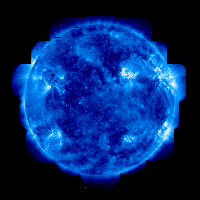

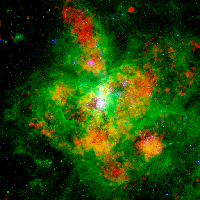
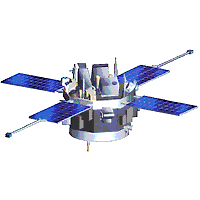
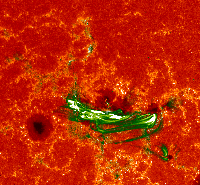
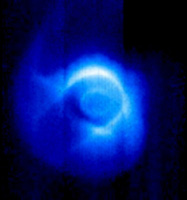
Questions and comments to: cosmicopia@cosmicra.gsfc.nasa.gov
Curator: Dr Eric R. Christian, NASA
Responsible NASA Official: Dr Eric R. Christian
Privacy Policy and Important Notices

HOME
In the News
History
Ask Us
Great Links
Glossary
Site Map
Search NASA